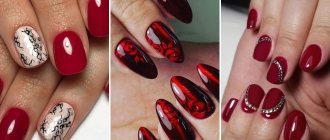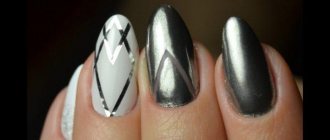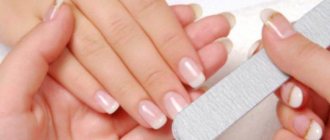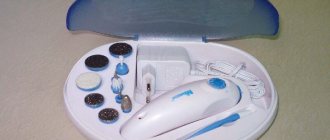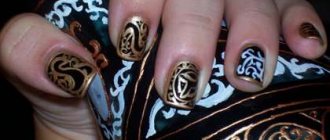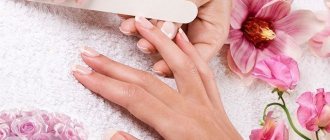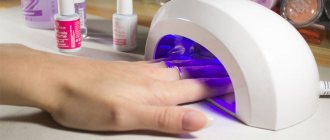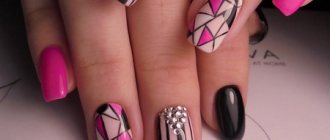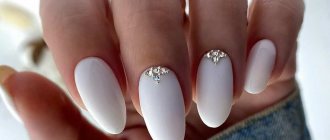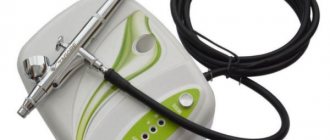What is a pusher (scraper)
A manicure scraper is a special device whose shape resembles a flat or slightly curved spatula, repeating the rounded shape of the nail plate.
It can be made of any materials - wood, plastic, silicone, but the highest quality and durable models are made of high-strength metal alloy. The tool is equipped with two working sides, each of which has a functional purpose.
A beveled or even blade is designed to form the shape of the hole by pushing back the cuticle and a special layer, the ptegirium, remaining on the surface. By pushing back the skin and freeing it, you can thereby speed up the growth of the plate.
The sharp cutter of a metal spatula helps cut off small defects, hangnails, and cuticle unevenness. The hatchet side must be used carefully so as not to damage adjacent areas.
Also, with the sharp part you can easily and quickly clean the free edge and side sinuses from dirt and give an aesthetic appearance. Manipulations allow beneficial substances to penetrate deep, nourishing, softening, and preventing the growth and dryness of the cuticle.
A manicure scraper (or pusher) combines the functions of several manicure tools.
A pusher is a professional tool that combines the functions of several manicure devices , such as orange sticks, nail curettes and even partially manicure scissors.
What it is
Excess skin (cuticle) constantly grows on the nail plate. It is removed when performing a manicure. When considering the question of what a nail pusher is and what it is needed for, the possibility of removing excess skin near the nail plate using a special tool that makes the task easier is taken into account. This device helps to push back the cuticle where it is needed.
The pusher provides the ability to model the shape of the nail hole. At the same time, it does not damage the integrity of tissues. There are no painful sensations either. A different tool is used to remove the cuticle. The pusher is a device with 2 working surfaces, which differ in configuration and solve different problems:
If a relief is applied to the work surface, it copes better with ingrown skin. In addition, the roughness allows this type of scraper to be used as a nail file if a special tool for grinding is not at hand.
Kinds
A scraper is a professional tool, but can easily be used to create a manicure at home. One aspect of quality and safe care is the optimal choice.
Main classification:
- Medical devices used in the dental industry.
- For pedicure , used to care for nail plates on the feet.
- Manicure . This type of tool is used to treat fingernails and can be used in salons or for home care.
By shape, scrapers are divided into round, oval, square and flat.
There is a more detailed classification, subdividing scrapers by shape:
- Flat . The shape is classic, but is rarely used because it does not have the required bend to fit the shape of the nail.
- Oval . The safest devices can be used even by inexperienced manicurists at home, as they do not have sharp corners that can injure the delicate skin around the plate.
- Square . Suitable for manicure of square shaped nails.
- Round . Safe, without sharp protruding corners, tools allow you to process the edge of a classic almond-shaped plate in detail.
Depending on the material used, there are scrapers:
- made of plastic;
- silicone;
One type of scraper is silicone
- wood;
- medical steel.
The latter are the most popular, characterized by a long service life, safety, functionality, and are subject to sterilization. Plastic and silicone models are subject to only superficial disinfection; the material is not suitable for high-temperature processing.
But for highly sensitive areas of the skin, a polyurethane pusher with a rounded hoof-shaped tip is suitable, as it can delicately push back the cuticle and gently cleanse the platinum from ptegirium.
A separate type of pushers - with a wide working surface in the form of a knife-spatula. Such models are designed for working with ingrown nails and treating wide nail plates; they are more often used for pedicures.
The device is not recommended for use at home without professional training, as it can damage the plate and injure the tissue around it.
According to the functional purpose of the blades there are:
- one-sided, with one working surface;
- double-sided, with two working surfaces, for pushing back the cuticle and cleansing the skin of ptegirium;
- with rubber tips for safe treatment of sensitive areas;
- with a straight or beveled blade;
- with a peak tip to remove dirt from the free part of the nail and sinuses.
For a quality tool, all working parts that ensure functionality must be unscrewed. This will ensure ease of service, sharpening, and disinfection so that the pusher can serve for many years.
To prevent slipping in your hands, the scraper handle is covered with threads with deep grooves for ease of manipulation. Small notches are used to easily file away excessively ingrown skin and model the shape.
Essence
Essence nail pushers are used to gently remove cuticles, which is why they have special ceramic tips. This material allows you to gently and painlessly remove the skin around your nails. Pushers of this brand are professional tools. The manufacturer produces many pushers with a rubber tip. These devices are designed for thin and sensitive skin around the fingernails.
Tool selection rules
Those who do their own manicure need to choose a high-quality pusher. The aesthetics and safety of the manicure depend on how well the shape, material and additional functionality suit the individual case.
When choosing a scraper, you must take into account the shape of the tool, focusing on the shape of your nails
The device must be individual or be fully sterilized after each use.
To choose the right scraper, you need to follow simple tips:
- Quality . For permanent use, it is recommended to choose a scraper made of high-alloy medical steel. Such a tool, subject to the rules of use, timely sharpening and regular disinfection, can serve for decades.
- Form . One of the important aspects is the optimal shape of the scapula, which should match the shape of the nail plate. The algorithm is simple: the narrower the plate, the narrower the working surface of the blade should be.
It is also necessary to pay attention to the shape, since square is not suitable for almond-shaped nails, and vice versa. The oval shape of the manipule is considered universal , allowing you to carefully push back and remove the cuticle, working with any shape of the nail.
- Functionality . In this aspect of the choice, it is important to proceed from individual preferences, choosing either a classic one-sided blade or a double-sided working surface.
- Manufacturer and place of purchase . When purchasing a tool, you need to give preference to branded models, focusing on the reviews and reputation of the manufacturer. Also, purchases should be made at specialized sales points, avoiding stalls in markets.
- Convenience . Comfort while using the scraper is fundamental. The scraper handle should fit comfortably in the hand and have an optimal length in accordance with the length of the master’s hand.
There are models with lengths from 110 to 150 mm; the larger the master’s brush, the longer the scraper should be. The handle should not slip or twist during manipulations; this can lead to injury to the plate and surrounding tissues.
The most popular manufacturer brands are Lazeti, YoKo, Zinger, OPI, Metzger. Today, universal models are offered that allow for several manicure processes.
An interesting new product in the beauty industry is a spatula with a magnetic surface, which allows you to create an intricate design on your nails.
Let's delve into the details: what is a nail pusher?
For many beginners who have never tried to take care of their hands on their own before, the manicure set will contain a colossal number of various new items, the purpose and use of which is completely vague and incomprehensible. Among them there will definitely be a pusher for manicure, which is also called a scraper. Let's figure out what it essentially is, what function this tool performs, how to choose it and how to use it correctly.
Important
Understanding what a pusher is or, as it is also called, a scraper, you can find out that it is a manicure tool in the form of an almost flat (slightly convex) plate-stick, most often made of metal, but it can be plastic or wooden. The device is double-sided, and in most cases serves to push back the cuticle before or instead of trimming it, after soaking it in warm water. The appearance of the scraper resembles a spatula, which follows the curve of the nail plate.
In addition to pushing back the cuticle, the scraper often has a second working surface; it can perform a variety of functions. For example, a special hatchet can be used to remove the pterygium (a thin layer of dermis) remaining on the nail after the cuticle is moved. This side of the pusher often has a pointed edge, so you need to work with it extremely carefully and gently. But other devices can be placed on the back of this tool, it all depends on the selected type, type, and manufacturer.
Types and types of pushers on the market
In the photo below, you can clearly see what manicure pushers can be presented on the market and what varieties exist. Basically, all types of convenient scrapers currently available for sale can be divided into three main subcategories, which determine their use.
Photo: types of pushers
- Medical pushers are used exclusively for medical purposes, for example, to correct the shape of the nail, remove ingrown edges, and so on.
- Pedicure scrapers are designed to work with toenails; they are most often made of durable and reliable metal. All working surfaces of such a tool are larger than in other cases.
- A manicure cuticle pusher is the most common and in demand nail care tool on the market. Such scrapers can be single-sided or double-sided, the tips of which are oval, rectangular, square, flat and convex.
Doctors, as already mentioned, can be made from a wide variety of materials, for example, stainless medical steel, orange wood, polymers and others. They can also be combined, for example, plastic with metal attachments and others. It’s really difficult to say which option is most acceptable, because everyone’s nails are different, and people’s preferences are also not the same.
How to choose the right nail pusher
Having finally figured out what a manicure pusher is, you also need to figure out how to choose the right tool for yourself so that working with your nails becomes not a terrible necessary chore for you, but a simple task that you do with pleasure. Experts recommend listening to the useful and practical advice that we present to your attention.
- You should not purchase scraper from inappropriate retail outlets, for example, from market stalls. It is better to give preference to a branded product, even if the cost is slightly higher, but it will last many times longer and will not fail at the most inopportune moment.
- The material used to make the scraper is very important, and among professionals, those made from medical steel are considered the best. However, wooden pushers themselves have some disinfecting effect, but only if they are made from orange wood. Plastic scrapers are suitable as a temporary option while others are not available, as they break very quickly and become unusable.
- It is important to choose the right tool sharpening. It should be sharp enough to easily remove cuticles and pterygium, but not so sharp as to injure the nail. To check, simply run the work surface lightly over your palm. If no scratches or unpleasant sensations arise, then you can buy the tool.
- Ease of use is very important, so make sure that the scraper handle fits well in your hand and does not slip or twist, otherwise injuries from slipping, especially with the correct sharpening, cannot be avoided.
The correct choice of the shape of the working surface of the scraper also plays an important role, and here the main criterion will be the own shape of the nails. Professionals prefer to have a whole diverse set of tools, but for ordinary people this can result in a very significant amount, since the cost of professional tools on the market today is quite high. For narrow, elongated nails, take an oval pusher, and for wide ones, you can take a square, round, flat, and so on. “Try it on” to your nail and you will immediately understand whether it suits you or not.
Nail preparation
A manicure scraper allows you to quickly and comfortably remove the cuticle by pushing it back and then cutting it with a beveled part or scissors.
In order for the procedure to be as safe as possible and without injury, it is necessary to provide the nails with preparation, which takes place in several stages:
- Cleaning from varnish and dirt. This is done using special means; it is recommended to use a composition without acetone, which overdries the plate and contributes to its structural destruction.
- Simulation . Before starting the step-by-step manicure procedure, it is necessary to perform modeling, giving the nails a shape. It can be anything, but it is recommended to follow a simple rule, choosing a shape in accordance with the cuticle line.
For example, if the line has an oval curve, then slightly rounded, almond-shaped or classic oval-shaped nails look most harmonious. For processing, choose a file with a fine diamond or mineral coating.
Before using a scraper for manicure, you should give your nails the desired shape and steam them for better cuticle removal.
- Steaming . To make the surrounding skin more pliable, it needs to be softened. To do this, prepare a bath of hot water, into which your hands are immersed for 5-10 minutes.
- To soften the cuticle, you can add 1 tbsp. l. sea salt, and also additionally use decoctions, special products, creams, oils, scrubs. At this stage, not only the softening of the keratinized skin occurs, but also the strengthening of the plate.
- After softening the skin, dry your hands with a clean cotton towel, blotting off any remaining moisture. The cuticle is additionally treated with an emollient and the treatment with a scraper begins.
How to use for cuticles
The main purpose of the scraper is to gently push back and remove the cuticle, freeing and modeling the nail hole for accelerated growth and external aesthetics of the hands.
The pusher blade is easy to use without any relevant experience, but it is important to follow the given algorithm:
- Select the right tool based on the material of manufacture and the shape of the plate. For hard cuticles, it is better to use a metal device. To remove sensitive and soft skin around the nail, use a device made of plastic or silicone.
- Moisturize the skin around the nail. This will help make the cuticle removal process easier. When removing hard and dry skin, there is a high risk of damage and pain during manipulation.
- Treat the cuticle with softening oil, leaving it to act for 1-2 minutes.
- Using a spatula, move the peel away from the edge to its base with progressive movements, holding the tool at a strictly 45-degree angle. Pressing too hard may damage the plate. Repeat the manipulation with each finger.
- Use the sharp side of the tool to get rid of the cuticle, carefully cutting it off. If the cuticle is quite wide and thick, it is better to use scissors. After the procedure is completed, the cuticle is lubricated with softening and nourishing oil of peach or grape seeds, tea tree, avocado or lavender.
If there are burrs, you can remove them under the base with scissors; dirt can be easily removed with the sharp part of the pusher. If the cuticle does not move well, and the procedure itself causes discomfort, you should simply increase the time of softening the skin in water.
It is necessary to act carefully and carefully , since rough manipulations can lead to injury to the nail, contribute to curvature and slow down the growth of the plate.
After the procedure, the scraper must be disinfected; it is recommended to store the instrument in a special case.
The pusher is double-sided. The convenience of a manicure cuticle pusher
To ensure that your hands always look neat, your nails require constant care and attention. You need to use special nail strengtheners, give them an ideal shape, push back and remove the cuticle. If you prefer to do manicures at home, then you need to have a quality tool on hand. These are all kinds of scissors, tweezers, files. It is difficult for a modern woman to do without a cuticle pusher. This little helper makes nail care a lot easier. Today we will tell you what a pusher is and how to use it correctly.
What is a pusher?
This is a manicure tool designed primarily for pushing back cuticles. In another way it is called a scraper. Some varieties are multifunctional, with working tools at both ends. For example, on one side there is a pusher blade, and on the other there is a hatchet, which is very convenient for removing pterygium.
This is an indispensable thing for manicure, which greatly helps to maintain the ideal condition of your nails at home. The pusher is also useful when removing gel polish and shellac from nails. On sale you can see models made of different materials, having all sorts of shapes and sizes.
Types of pushers
Pushers come in a wide variety of varieties. The choice depends on the purpose for which you are purchasing it and what you expect from this tool. Let's look at the most common types.
- One-sided. Their working tool is located only at one end. As a rule, this is a shoulder blade.
- Double sided. On one side there is a wide blade, which is used to push back the cuticle, on the other, there is a narrow part for removing the pterygium and cleaning the nails.
- Pedicure options have a wider working part.
- Models with a rubber tip that protects delicate skin from damage.
The instrument may also vary in shape. Pusher comes in the following types:
- oval;
- flat;
- semicircular;
- round;
- square.
How to use a pusher?
If you decide to do a manicure at home and have already prepared all the necessary tools, then remove the old varnish coating, wash your hands and you can get started.
- Treat your hands and tools with any antiseptic solution.
- Gently trim your nails with scissors so that they are the same length and give them the desired shape.
- Now you need to remove the cuticle. When it's dry, it's much more likely to damage the living skin, so it needs to be softened first. A warm bath with a decoction of herbs will help with this. You can add any essential oils if you wish.
- Dry your hands well with a towel and take the pusher. Use the wide part to gently push back the skin, freeing the nail bed. Do not press too hard, otherwise you will injure the delicate skin or nail plate.
- After the procedure, you may find that there are pieces of stuck pterygium on the nail. It is easy to get rid of it by using the pointed part of the pusher.
Do not forget to immediately treat the instrument with an antiseptic solution after use. If you use the pusher carefully and correctly, you will soon not be able to imagine performing a manicure without this tool.
How to choose a good tool?
When you come to the store, you may get confused by the variety of pushers. How to choose the one that will be most convenient to use? We would like to give you some small tips.
- First of all, evaluate the material. Pushers come in metal, wood and plastic. The last two types are used quite rarely due to excessive fragility. Therefore, it is better to choose metal. The best option is stainless medical steel.
- Pay attention to the sharpening. It should be quite spicy.
- The handle should be comfortable and not slip. It’s good if it is coated with plastic or has special notches that ensure a secure fit in the hand.
- Choose the shape depending on the characteristics of your nails. For example, if you have narrow nails, then your best option is an oval pusher. For wide ones, round, flat or square are more suitable.
- Run the working side over your palm. If you do not experience any unpleasant sensations, then you can safely buy the tool - it will not leave scratches on the skin.
Doing a manicure at home is not that difficult. The main thing is to take your time, choose a quality tool and act carefully. In conclusion, we invite you to watch a very useful video
, in which you will find a review and comparison of pushers of different shapes. If you are at the selection stage, be sure to pay attention to this wonderful video.
Removing gel polish
The manicure scraper can also be used to remove gel polish. There is an opinion that gel polish spoils the nail plate. In fact, if its composition does not contain harmful substances, the plate can be damaged by the procedure of improper removal of the color film. This can lead to thinning, delamination and structural damage.
In order to remove gel polish using a pusher, you must follow the recommendations:
- First, the nail is polished with a file, removing the finishing layer of gel. It is this that prevents the solution from penetrating inside, preventing the removal of the gel polish.
- Cut the cotton pad into four sectors. Moisten each sector in nail polish remover without acetone and apply it to the nail.
- Wrap each finger tightly with foil on top for better penetration of the solution. It is necessary to wrap with the glossy side of the foil inward, which is more capable of reflecting heat, directing it inward.
- It takes professional gel polish from 12 to 20 minutes to peel off from the nail. It is forbidden to lift the foil wrapper, since the ingress of oxygen has a depressing effect on the process of peeling off the varnish.
- After the film has come off, it is removed with a pusher, moving from the cuticle to the free edge. It is necessary to exfoliate without pressing the plate. If the varnish has peeled off well, it can be easily removed with a pusher.
Remains of gel polish can be removed by sanding the surface with a buff or an old file with a soft abrasive. This procedure may cause dry skin on your hands. After removing the gel polish, it is recommended to apply moisturizing cream or softening safflower oil with vitamin E to the skin, nail plate and cuticle, massaging each finger for better penetration of nutrients into the skin.
Instrument disinfection
A manicure scraper, like any instrument used for this procedure, must be subject to mandatory disinfection. According to practice, it is precisely because of violations of the sterilization and disinfection algorithm that clients are exposed to coccal infections, pediculosis, fungal infections, as well as more serious viruses that pose a serious danger to life and health.
Manicure instruments, including scrapers, are subject to mandatory disinfection
Regardless of the location of the manicure, the spatula, like any other instrument, must be regularly disinfected . Salons, as a rule, use a sterilization method, the principle of which is the complete destruction of germs and bacteria. It is in this way that dangerous viruses such as HIV and hepatitis can be destroyed.
Complete disinfection includes several stages:
- Mechanical cleaning . At the first stage, the instrument is cleaned of skin residues, particles, fatty traces, and residues used to soften and remove products. This is done using brushes and ends with rinsing under running water. If there are traces of blood on the shoulder blade in case of skin injury, it is necessary to first treat it with disinfectants.
- Disinfection . The working disinfectant solution is prepared according to specially established standards. Chemical compounds may be added to it in accordance with the list approved by the Ministry of Health. The composition is prepared according to the instructions, which indicate expiration dates, composition, proportions and concentration.
Lysoformin 3000 is often used to disinfect manicure instruments.
Disinfection can be carried out using Lysoformin 3000, Maxisan, Bionol forte, Diozone, Helipur and other approved compounds. At home, you can use alcohol with a concentration of 70%.
- Sterilization . There are several types of specialized sterilization chambers. For steel manicure instruments, sterilization is used in ultrasonic, dry-heat, quartz, ultraviolet cabinets and autoclaves. At home, sterilization is carried out by boiling, using a double boiler, oven and microwave.
By using a step-by-step disinfection algorithm, you can achieve complete sterility of the instrument, making the manicure procedure absolutely safe.
How to sharpen at home
The sharpening of the tool should be sharp enough so that in the process it does not form unevenness or hangnails on the skin. The sharper the sharpening, the safer the tool is to use. To check, just run the sharp end along the surface of the nail. If it remains intact and not scratched, then the tool is sharp enough.
Sharpening is carried out at least once a year. It can be carried out more often, it all depends on the frequency and characteristics of the pusher’s use, as well as the quality of the tool’s steel. The lost sharpness of the scraper can be restored at specialized points, where the pusher is sharpened by a master using special equipment.
If you need to sharpen an instrument urgently and there is no way to put the instrument in the hands of a professional craftsman, it is also possible to carry out a similar procedure at home:
- take sandpaper with a medium-grain coating;
- run the scraper over the paper several times strictly in one direction;
- Sand with fine-grained sandpaper (“zero”).
Such express sharpening will be enough for a pusher for 1-2 procedures, after which the procedure must be repeated or the tool must be given to a professional to restore the lost sharpness.
A convenient device for manicure is a scraper, with which you can comfortably and safely carry out the procedure at home and restore the aesthetics and healthy appearance of your nails. It is recommended to follow the advice for choosing a tool. And also for convenience and safety, you should follow the instructions for disinfection and use of the pusher.
Article design: Natalie Podolskaya
How to choose
Manicure, like any cosmetic procedure, should be performed only with high-quality tools. Otherwise, the risk of dangerous infections increases. To avoid such consequences, you need to know how to choose a pusher.
The most important criterion is the material of the product. You should choose only medical grade stainless steel! In stores you can also find a manicure pusher made of wood or plastic. However, they are not very popular because they are short-lived and break quickly.
The next thing you need to pay attention to is sharpening the tool. It is better if it is done manually. In this case, the pusher will be quite sharp to cut off unnecessary things without much effort. If the sharpening is done poorly, the tool will tear the skin, leaving small tails, from which hangnails are formed. A pusher that is too sharp will cause a lot of problems, because it leaves cuts.
The chosen tool should be comfortable. It's worth holding it in your hand to understand how well it fits in it. While working, you should not be distracted by discomfort, which significantly affects the quality of the result. The handle of the metal pusher has special notches that prevent the tool from slipping out of your hands.
The shape of the blade is selected individually. If a girl chooses it for herself, then just look at her own nail plate. A square spatula will not suit an almond shape. A universal option is an oval pusher.
You can determine whether a pusher is suitable in the following way: just run it across your palm. If there are no unpleasant sensations, then you can buy the tool.
